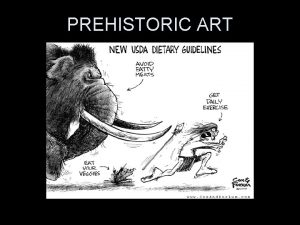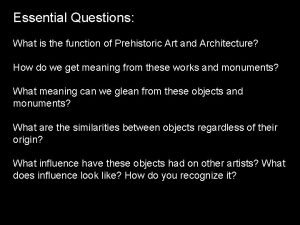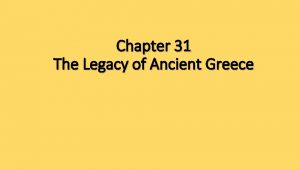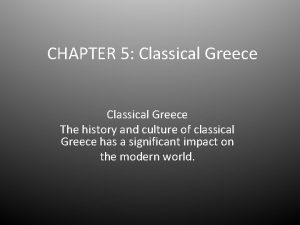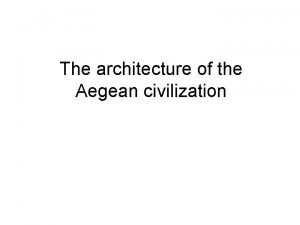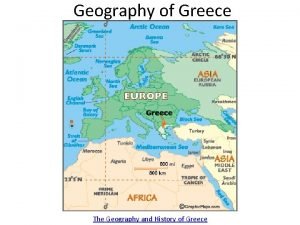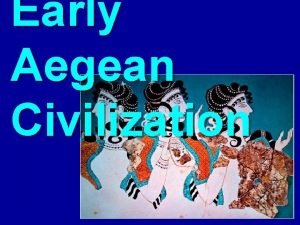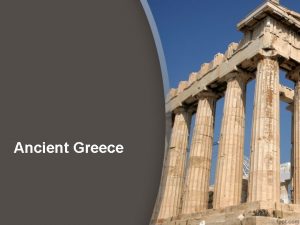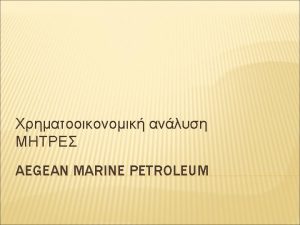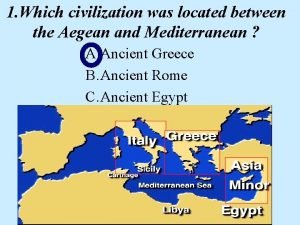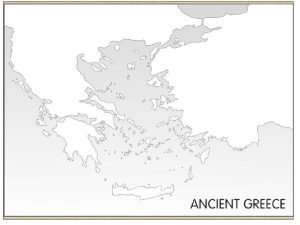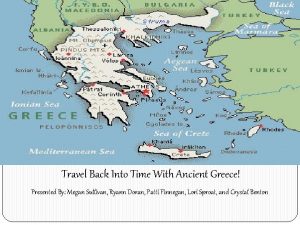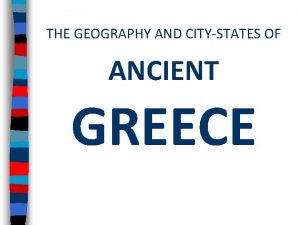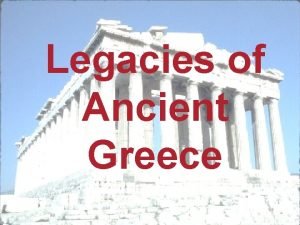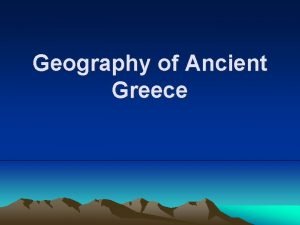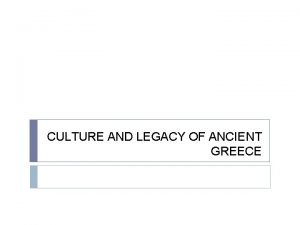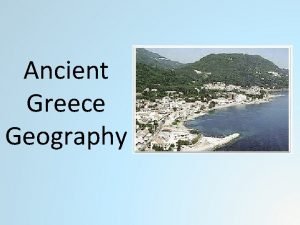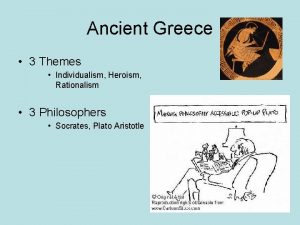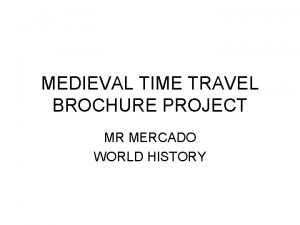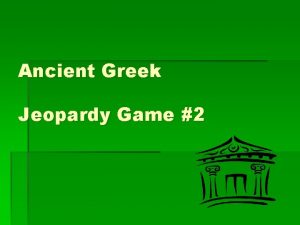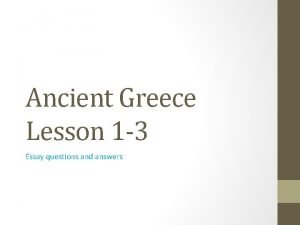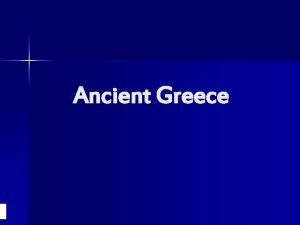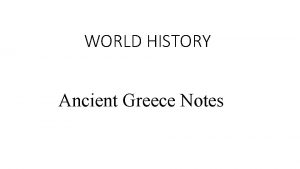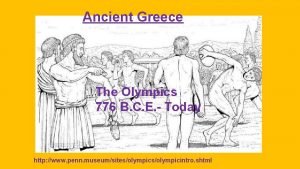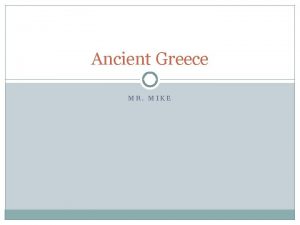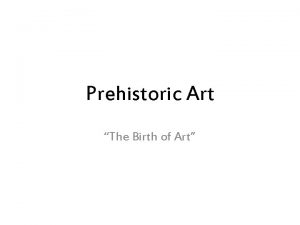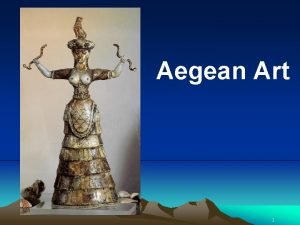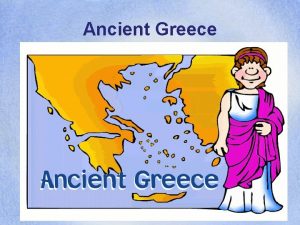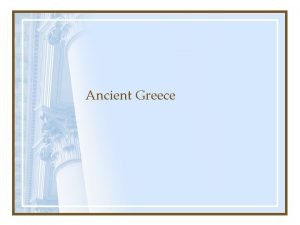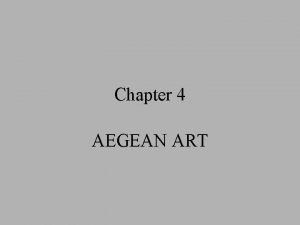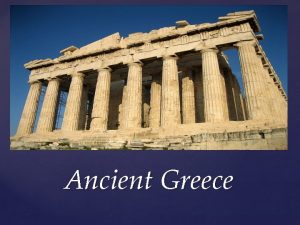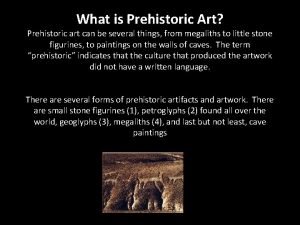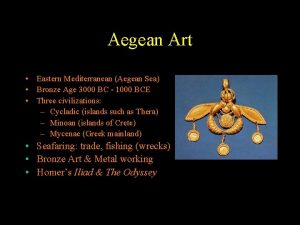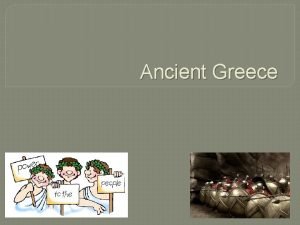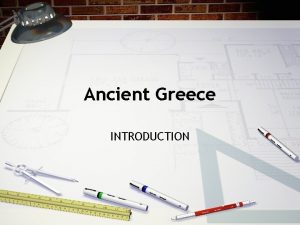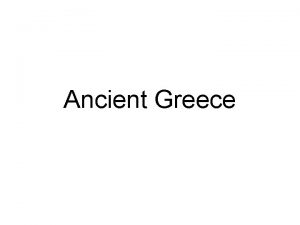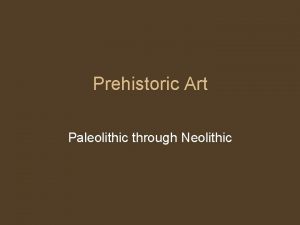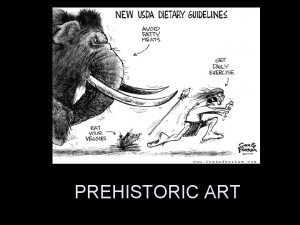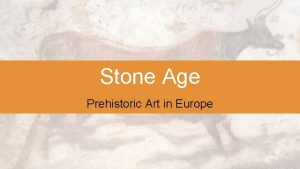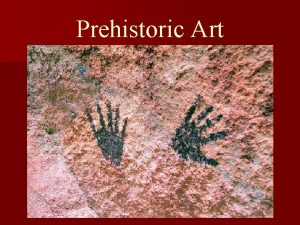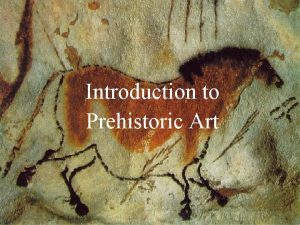Chapter Two Ancient Greece Prehistoric Aegean Art Dates






































- Slides: 38

Chapter Two Ancient Greece

Prehistoric Aegean Art Dates and Places: • 2500 -1200 BCE • Styles difined by regions: Cyclades Islands (Cycladic) Crete (Minoan) Peloponnesos (Mycenaean) People: • Kings, priests, warriors • Described in Homer’s Iliad

Prehistoric Aegean Art Themes: • Human figures • Nature • Funerary offerings • Palaces and citadels Forms: • Formal conventions vary • Post-and-lintel and masonry construction Stairwell in the residential quarter at the palace at Knossos, ca. 1700 -1400 BCE, Fig. 2 -4.

Prehistoric Aegean: Cycladic Dates and Places: • 2500 -1700 BCE • Cyclades Islands People: • Little known Example: • Schematic figures • Painted funerary offerings Figurine of a woman, ca. 2500 -2300 BCE, Fig. 2 -2.

Prehistoric Aegean: Minoan Dates and Places: • 1700 -1200 BCE • Island of Crete People: • Palace builders • Prosperous • Rituals involving animals Octopus jar, ca. 1500 BCE, Fig. 2 -7.

Prehistoric Aegean: Minoan Aerial view of the palace at Knossos, ca. 1700 -1400 BCE, Fig. 2 -3.

Prehistoric Aegean: Minoan Example: • Labyrinthine yet open palace plan • Light and air wells • Open courtyard • Wood columns with bulbous capitals • Administrative, commercial and religious center Aerial view of the palace at Knossos, ca. 1700 -1400 BCE, Fig. 2 -3.

Prehistoric Aegean: Minoan Bull-leaping from the palace at Knossos, ca. 1450 -1400 BCE, Fig. 2 -5.

Prehistoric Aegean: Minoan Example: • Palace fresco paintings of people and nature • Conventional representations by gender • Minoan figures slender and animated Bull-leaping from the palace at Knossos, ca. 1450 -1400 BCE, Fig. 2 -5.

Prehistoric Aegean: Mycenaean Dates and Places: • 1700 -1200 BCE • Mainland Greece People: • Kings and warriors • Prosperous • Ancestors of the Greeks Funerary mask, ca. 1600 -1500 BCE, Fig. 2 -13.

Prehistoric Aegean: Mycenaean Lion Gate, Mycenae, ca. 1300 -1250 BCE, Fig. 2 -10.

Prehistoric Aegean: Mycenaean Example: • Citadel built of Cyclopean masonry • Corbeled arch • Relief sculpture on relieving triangle • Inside: tholos with dome housing funerary goods Lion Gate, Mycenae, ca. 1300 -1250 BCE, Fig. 2 -10.

Greek Art Dates and Places: • 900 -30 BCE • Greek mainland nearby outposts People: • Democratic city-states • Human-centered • Poetry, philosophy, Olympic games • Worship of gods Kritios Boy, ca. 480 BCE, Fig. 2 -31.

Greek Art Themes: • Humans • Mythology • Trojan War Forms: • Conceptual→Optical • Doric, Ionic and Corinthian orders • Mathematical proportion Restored façade of the Temple of Aphaia, Aegina, ca. 500 -490 BCE, Fig. 2 -28.

Greek: Geometric and Archaic Geometric krater, ca. 740 BCE, Fig. 2 -14.

Greek: Geometric and Archaic Example: • Abstracted human figure • Storytelling • Two-dimensional Geometric krater, ca. 740 BCE, Fig. 2 -14.

Greek: Geometric and Archaic Kroisos, ca. 530 BCE, Fig. 2 -17 and Peplos Kore, 530 BCE, Fig. 2 -18.

Greek: Geometric and Archaic Example: • Archaic kouros (female version is kore) • Egyptian pose but with motion • Nude hero • Archaic smile and paint to look lifelike Kroisos, ca. 530 BCE, Fig. 2 -17.

Greek: Geometric and Archaic Temple of Hera, ca. 550 BCE, Fig. 2 -21.

Greek: Geometric and Archaic Example: • Doric temple • Mathematical order and proportion • Cult statue and pediment frieze reliefs Temple of Hera, ca. 550 BCE, Fig. 221.

Greek: Geometric and Archaic Euthymides, Three Revelers, ca. 510 BCE, Fig. 2 -26.

Greek: Geometric and Archaic Example: • Red-figure vase painting • Signed by artist • Narrative with varied poses • Red-figure painting allows for more detail • Foreshortening Euthymides, Three Revelers, ca. 510 BCE, Fig. 2 -26.

Greek: Classical Polykleitos, Doryphoros, ca. 450440 BCE, Fig. 2 -35.

Greek: Classical Example: • Marble copy of hollowcast bronze sculpture • Contrapposto with ordered human motion • Asymmetrical balance • Canon of proportion Polykleitos, Doryphoros, ca. 450 -440 BCE, Fig. 2 -35.

Greek: Classical Restored view of the Acropolis, Athens, Greece, Fig. 2 -36.

Greek: Classical Example: • Doric Temple of Athena on Acropolis • Relief sculpture in pediments and friezes • Symmetria from numerical ratios • Adjusted for viewer’s eye Plan of the Parthenon, Acropolis, Athens, Greece, 447– 432 BCE, Fig. 2 -37.

Greek: Classical Achilles Painter, Warrior taking leave of his wife, ca. 440 BCE, Fig. 2 -46.

Greek: Classical Example: • White-ground lekythos • Emulates polychrome painting • Scene of daily life Achilles Painter, Warrior taking leave of his wife, ca. 440 BCE, Fig. 2 -46.

Greek: Late Classical Praxiteles, Aphrodite of Knidos, ca. 350 -340 BCE, Fig. 2 -47.

Greek: Late Classical Example: • Late Classical less interested in order and perfection • Sensuousness despite modest pose • Roman marble copy Praxiteles, Aphrodite of Knidos, ca. 350 -340 BCE, Fig. 2 -47.

Greek: Late Classical Philoxenos of Eretria, Battle of Issus, ca. 310 BCE, Fig. 2 -50.

Greek: Late Classical Example: • Roman mosaic copy of Greek painting • Natural light and shadows • Motion and expression • Foreshortening • Alexander versus Persian king Darius Philoxenos of Eretria, Battle of Issus, ca. 310 BCE, Fig. 2 -50.

Greek: Hellenistic Altar of Zeus, ca. 175 BCE, Fig. 2 -52.

Greek: Hellenistic Example: • Kingdoms rise after death of Alexander • Monument to Zeus • Motion, emotion, drama • Dramatic light and shadow for narrative Altar of Zeus, ca. 175 BCE, Fig. 2 -52.

Greek: Hellenistic Old market woman, ca. 150 -100 BCE, Fig. 2 -58.

Greek: Hellenistic Example: • New interest in realism versus idealism of Classical era • Representation of aging process • Different types of people, not just heroes and gods • New social climate Old market woman, ca. 150100 BCE, Fig. 2 -58.

Greek: Hellenistic Athanadoros, Hagesandros, and Polydoros of Rhodes, Laocoön, first century CE, Fig. 2 -59.

Greek: Hellenistic Example: • Sculpture for Roman patron • Found in Emperor Titus’ home, described by Pliny • Trojan priest punished by gods • Emotional through pose and facial expression Athanadoros, Hagesandros, and Polydoros of Rhodes, Laocoön, first century CE, Fig. 2 -59.
 Agean art
Agean art Prehistoric art notes
Prehistoric art notes What is the function of prehistoric painting
What is the function of prehistoric painting Classical art 2 000bc-400 bc
Classical art 2 000bc-400 bc Ancient greece contributions
Ancient greece contributions The legacy of ancient greece
The legacy of ancient greece Chapter 5 classical greece
Chapter 5 classical greece Aegean civilization
Aegean civilization Labeled ancient greece map
Labeled ancient greece map Aegean civilization
Aegean civilization Dover beach metaphor
Dover beach metaphor Led soldiers across hellespont into anatolia goals
Led soldiers across hellespont into anatolia goals Aegean peninsula
Aegean peninsula Aegean free zone
Aegean free zone Aegean marine petroleum network inc
Aegean marine petroleum network inc Aegean dividend miles
Aegean dividend miles The earliest aegean civilization was located
The earliest aegean civilization was located Locate and label the cities of athens and sparta
Locate and label the cities of athens and sparta Where was ancient greece located
Where was ancient greece located Romans invade greece
Romans invade greece Ancient greece physical education
Ancient greece physical education Legacy of ancient greece
Legacy of ancient greece Sparta greece map
Sparta greece map What can we learn from studying ancient greek artwork
What can we learn from studying ancient greek artwork Greek music instrument
Greek music instrument What did the ancient greeks value
What did the ancient greeks value What continent is greece located
What continent is greece located Geography in ancient greece
Geography in ancient greece Ancient greece balkan peninsula
Ancient greece balkan peninsula Why did tyrants fall out of favor with the greeks?
Why did tyrants fall out of favor with the greeks? School of athens individualism
School of athens individualism Aristotle direct democracy
Aristotle direct democracy Ancient greece travel brochure project
Ancient greece travel brochure project Ancient greece jeopardy
Ancient greece jeopardy Ancient greece essay topics
Ancient greece essay topics Is greece a peninsula
Is greece a peninsula Mycenae ancient greece map
Mycenae ancient greece map Ancient greece theatre masks
Ancient greece theatre masks üget
üget

